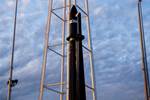Rocket Lab launches climate science satellites for NASA
The first of two satellites were deployed on the company’s composite Electron rocket for the PREFIRE mission to detect heat loss over the Arctic and Antarctica.
Shown here are the twin Electron fairings for NASA’s two PREFIRE launches. Source (All Images) | Rocket Lab USA Inc.
On May 25, Rocket Lab USA Inc. (Long Beach, Calif., U.S.) launched the first of two back-to-back launches for NASA’s (Washington, D.C., U.S.) Polar Radiant Energy in the Far-InfraRed Experiment (PREFIRE) mission, specifically tasked with measuring heat loss from both the Arctic and Antarctica, in an aim to help researchers better understand Earth’s energy budget. The launch was achieved via the company’s composite Electron rocket.
‘Ready, Aim, PREFIRE’ lifted off from Rocket Lab Launch Complex 1 in Mahia, New Zealand, at 7:41 p.m. NZST. The launch deployed the first of two satellites for the PREFIRE mission to a 525-kilometer circular low Earth orbit (LEO). Now that the first satellite has been successfully deployed, the second will follow on another dedicated Electron launch in just a few days. The launch date for the next mission, ‘PREFIRE and Ice’ will be confirmed early next week.
Rocket Lab’s ability to launch dedicated missions to precise orbits on demand is critical to the success of PREFIRE. The mission requires two separate satellites to follow similar trajectories but along different paths to overlap with each other every few hours near the Arctic and Antarctica and capture accurate heat loss measurements. Both PREFIRE satellites are equipped with a device called a thermopile, similar to sensors found in household thermostats, to measure heat loss at far-infrared wavelengths which have never been systematically measured before, according to the company. This data collected by the PREFIRE mission will help to improve climate and ice models and provide better predictions of how the planet’s sea level and weather are likely to change in the future. Watch the complete launch in the video below.
“Missions like PREFIRE demonstrate the benefit of Electron — dedicated launch for small satellites to precise orbits on precise schedules,” Rocket Lab founder and CEO, Peter Beck, says. “We’ve demonstrated this back-to-back launch capability for NASA once before with the TROPICS mission [May 2023] and we’re excited to deliver it once again for PREFIRE.”
This successful mission was Rocket Lab’s 48th Electron launch overall and sixth launch of 2024.
Related Content
-
Partners recycle A350 composite production waste into adjustable-length rods for MFFD
Herone, Spiral RTC, Teijin Carbon Europe and Collins Aerospace Almere recycle A350 thermoplastic composite clips/cleats waste into rods for the all-thermoplastic composite Multifunctional Fuselage Demonstrator’s crown.
-
Rocket Lab begins installation of large AFP machine for rocket production
The 99-ton AFP machine, custom-designed and built by Electroimpact, is claimed to be the largest of its kind, expecting to save around 150,000 manufacturing hours in the Neutron rocket’s production process.
-
Cryo-compressed hydrogen, the best solution for storage and refueling stations?
Cryomotive’s CRYOGAS solution claims the highest storage density, lowest refueling cost and widest operating range without H2 losses while using one-fifth the carbon fiber required in compressed gas tanks.


















